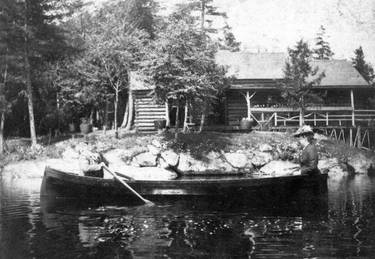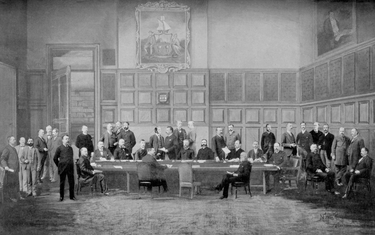Thacher was a man of ideas and action
— Photo submitted by Timothy Albright
Preparing for a celebration: In 1886, planning was a priority for Albany’s Bicentennial. Pictured among the men organizing the gala is John Boyd Thacher, then mayor of Albany, seated at the far right end of the table. Thacher welcomed Caughnawaga Indians along with a contingent from Holland to the festivities.
John Boyd Thacher was one of the most distinguished and revered Albanians of his day. He was born at Ballston, Saratoga County on Sept. 11, 1847, the elder son of George Hornell and Ursula Jane (Boyd) Thacher. His father married his mother in 1843. She was the daughter of David Boyd, Esq. of Schenectady.
John Boyd Thacher had a younger brother named after his father, George Hornell Thacher, who was born in Albany on Nov. 20, 1851.
Thacher family history extended back several centuries to Reverend Thomas Thacher, who was the pastor of the the famous Old South Church of Boston in 1670. The family is said to be of Scotch-Irish origin.
Thomas Thacher was the son of Rev. Peter Thacher of Somerset, England and was born on May 1, 1620. He sailed to New England on the ship James with the family of his uncle, Anthony Thacher, arriving in Ipswich, Mass. on June 4, 1635.
Rev. Thomas was educated in theology and medicine. In Boston, he practiced medicine from 1664 to 1670.
Members of the Thacher family were later known to be active patriots during the Revolutionary War. The spirit of freedom was exhibited by John Thacher’s father, George, in 1859, when he faced an angry mob while demanding and obtaining a hearing for Wendell Philips, Frederick Douglas, Gerrett Smith, and other abolitionists just prior to the Civil War.
George Hornell Thacher, the elder, was one of Albany’s most prominent businessmen. He was born in Hornellsville on June 4, 1818 and was the son of Samuel Olney Thacher and Martha Hornell, daughter of Hon. George Hornell, after whom Hornellsville was named.
Public service was a trait passed from father to son in the Thacher family. George Thacher began his career as a railroad-car wheel manufacturer in 1852. He established a well known plant in Albany at the intersection of Thacher and Learned streets, supplying most of the car sheels for the New York Central Railroad.
The business was known as The Thacher Car Works and produced many parts for the construction of railroad cars. This made the Thacher family very wealthy.
George Thacher was honored to be major of Albany for four non-consecutive two-year terms between 1860 and 1874, including much of the Civil War. He was earlier elected alderman in 1859.
Mayor Goerge Thacher was known as “that old warhorse of democracy.”
All of the Thacher family ancestors exhibited a thirst for knowledge that continued with John and his brother, George.
Mayor George Thacher died on Feb. 25. 1887.
John Boyd Thacher’s early education was received from private tutors at Albany and Frederick, Md. In 1865, he entered Williams College, graduating in 1869 with high honors.
Sometime following graduation, he went to work as an iron molder in his father’s foundry. He worked for several years, perfecting his skills at the foundry while taking accounting classes at night at Folsombs Business College (a forerunner of Albany Business college) on Pearl Street.
He married Miss Emma Treadwell on his 25th birthday in 1872. She was the daughter of Geroge Curtis Treadwell, Esq. of Albany. Mr. Treadwell’s grandfather was a member of the Colonial Congress and the last of the puritan governors of Connecticut.
JohnThacher soon took an active roll in the management of his father’s foundry and became a partner on Jan. 1, 1873. The Thachers were known to always have paid the highest wages for skilled labor.
John Thacher carried on his family’s belief in service to community and country. While in his first appointment as a public servant to the Albany Board of Health, Thacher was alerted to the hazards of living in tenements in Albany and the greater New York City area.
Thacher, a Democrat, was elected state senator from Albany in 1883. As senator, he pushed through legislation establishing a commission to remedy tenement-housing problems. The commission was responsible for several successful new laws benefiting poor tenement dwellers.
He also introduced a bill to spend one million dollars for the construction of the State Capital Building in 1884. The legislation authorizing the new building was carried although there was strong opposition.
Thacher fought to improve the prison system and also joined then-Governor Grover Cleveland to reform corruption laws in government.
He was very proud to introduce a resolution calling upon Congress to pension General Grant who had served as president and was dying of cancer.
Senator Thacher also had a great interest in the work of the State Trigonometrical Society and persevered in the funding of their efforts to map the topographical and hydrographical nature of New York State. Up until this time, detailed maps of the state were incomplete or unknown.
He had become acquainted with a surveyor named Verplanck Colvin who was also born in 1847. Colvin later became superintendent of the Adirondack Survey from 1872 to 1900. Colvin’s family also believed in public service.
Colvin’s father, the honorable Andrew James Colvin served as a Democratic Senator, representing Albany County from 1860 to 1861. He had written an act broadening women’s legal rights and pushed for the abolishment of the death penalty. Andrew was well respected by Albanians and the legislature.
He was asked join President Abraham Lincoln on a visit to Albany. Later, with the onset of the Civil War, the honorable Colvin fired up Albanians by repeating Lincoln’s words in an inspiring speech saying, “This country could be wholly slave or wholly free” and later finished, stating, “The contest is upon us sir and let it come.”
By 1860, his son Verplanck Colvin, decided he was going to promote his idea of an Adirondack Forest Preserve or Park. He first needed to make maps of the entire region, including a topographical and geological survey.
At only 22 years old, Verplanck Colvin thought he might hone his skills at surveying in the Helderbergs. He stated his work with a train trip from Albany to Meadowdale and went on to the Indian Ladder region of the Helderberg escarpment.
His account of this trip is fantastically descriptive and accompanied by his own illustrations in Harpers Monthly Magazine of October 1869. It covers the area now encompassing present-day Thacher Park. If you have not read it, you should.
John Thacher was a lover of the out-of-doors and the Helderbergs, which were visible from Albany. As senator, he continued to advance the work of Verplanck Colvin as a visionary and important contributor to the preservation of the Adirondacks to our north.
In 1886, while Albany was celebrating its Bicentennial, John Boyd Thacher served his first term as mayor of that city. It was said that his administration of Albany and the four-day bicentennial celebration “showed exceptional brilliance and would not be forgotten by those who witnessed it.”
During the celebration on July 18,1886, Thacher welcomed a group of Caughnawaga Indians as well as representatives from Holland who were later entertained with much fanfare, including a large fireworks display and parade.
In February 1888, Thacher successfully organized a winter carnival at Albany that lasted three days and was the first even south of Montreal. The event came off so perfectly that Albanians considered “Thacher’s Luck” to be responsible.
Mayor Thacher gave the city of Albany the lowest tax rate in 1887 since the Civil War. His administration’s achievements include a new Public Market Square; Harmanus Bleeker Hall; and, during his second term of 1896, the unforgettable Union Station.
He was said to be a man of ideas who knew how to present them; a man of action, enterprising, honorably ambitious and representative of the people as a whole, considering business as well as culture with thoughtfulness; a valuable man whose reputation is without stain; a man who cannot be bought.
He advanced and promoted any cause in the interest of the city of Albany, rivaling all men who preceded him. The people of Albany were beloved by Mr. Thacher and his best efforts were given to them, the businessmen, and the city, to advance its continued growth and prosperity. He was active in city issues until his health failed in later years.
In 1890, Thacher was appointed by both Governor David Hill and President Benjamin Harrison as New York State’s delegate and chairman of the Executive Committee on Awards at the World Columbian Exposition until 1895. The Columbian Exposition, just like Washington and the District of Columbia, were named in recognition of the worldwide honor bestowed upon the historic efforts to discover America by Christopher Columbus, nearly 400 years earlier.
Thacher also participated on the Expositions Advisory Council on World Congresses. John Thacher worked effectively as president of the New York State League of Democratic Clubs during the presidential campaign of 1892.
While Thacher was serving his second term as mayor of Albany in 1896, the New York Democratic Party nominated Thacher for governor. But, when his criticisms of the party differed with the presidential candidate, William Jennings Bryan, he was pressed step down.
Mr. Thacher was a Freemason, a member of the Clinton Square Presbyterian Church, and a philanthropist and patron of the arts. He was an early history detective, author, scholar, and collector of rare books, and pieces of Americana.
His book and manuscript collection was vast, including over 500 pieces from the 15th Century. He had an autograph collection of over 25,000 signatures said to be one of the most valuable and extensive collections in the work, including a complete compilation of the original signers of the Declaration of Independence.
Thacher wrote books himself, on Shakespeare, the discovery of America, Cabotian voyages, the continent of America, and extensive research into the life and explorations of Christopher Columbus. Unknown to him at the time, a book was published of his speeches marking the great ability he had with words and the oratory.
He was fascinated with the life of Christopher Columbus and owned the famous Castillo lockets containing the bones and dust of Columbus. These were later displayed by his heirs at the New York world’s Fair with a value of $500,000. His collection of Indian relics was ne of the most valuable in the stae.
The Honorable John Boyd Thacher died before noon on Thursday, Feb. 25, 1909, (same day as his father) at his home, at 5 South Hawk Street in Albany. Mayor Henry F. Snyder set flags at half-staff at municipal buildings around the city.
Sorrow was expressed by many throughout the city, including a meeting of the mayor, former mayors, municipal department heads, as well as political friends, professional and businessmen.
Thacher’s crypt is at Albany Rural Cemetery and has a stained-glass window designed with a Spanish Cross commemorating the one that appeared on the Santa Maria, the lead ship for Christopher Columbus.
John and Emma Thacher were constant companions. They enjoyed extensive travels to the Orient and Europe. At home and abroad, the two were devoted to one another. They did not have children. The years’ activities were divided between Europe, Albany, and their summer residence in Altamont below High Point.
Many times, John Boyd Thacher has been confused with his brother George’s son who was named in his honor. John Boyd Thacher II served as mayor during the 1920s and hosted a large reception for Charles Lindbergh in 1927 in celebration of his trans-Atlantic flight. In 1939, he and Mr. Thacher, along with other Albanians went to the New York City World’s Fair to celebrate “Albany Day.”
As an Albanian, the first John Boyd Thacher had always been aware of the Helderbergs and the famous Indian Ladder lore of the escarpment area. John and Emma Thacher became familiar with Andrew Green in the 1890s.
Green was known as the “Father of Greater New York” and founder of The American Scenic and Historic Preservation Society. It was “A National society for the Protection of Natural Scenery, the Care of Public Parks, the Preservation of Historic Landmarks and the Improvement of Cities.
In 1895, Green spoke to the New York State Legislature and stated, “Areas of primitive natural beauty are being seized upon for private uses and for profitable enterprises that are not unlikely to exclude the public from their enjoyment.” The Thachers believed in this statement and the mission of “American Scenic.”
While summering in Altamont and Visiting the Indian Ladder area and Thompsons Lake, they became friends with Professor Theodore C. Hailes for whom Hailes Cavern was named.
Land was available for sale on the Helderberg Escarpment. Emma and John Thacher decided to purchase farmland around the site of the Indian Ladder and Thompsons Lake so that its natural beauty would be preserved for eventual public use. Farmers in the area were giving up the hard life of trying to make a living along the escarpment for more industrialized jobs in the city nearby.
The 350 acres the Thachers purchased around the site of the historic Indian Ladder seemed to be the heart of the escarpment. After John Thacher’s death in 1909, Emma Thacher secured an agreement with the state of New York that was publicly declared at a Dedication Day Ceremony on Sept. 14, 1914, stating that the land was being given to the people of the state of New York and to be forever known as John Boyd Thacher State Park.
Emma Thacher personally chose the American Scenic and Historic Preservation Society as custodians of the Park and John Cook, the first superintendent of the Park, she highly respected both.
She was elected an honorary patron of American Scenic and also a member of the board of trustees. She also served as a member of the John Boyd Thacher Park Committee.
In 1920, she donated 50 more acres to the state on the northwest side of Thompsons Lake. She died in 1927.
The bulk of the Thacher estate was left to Emma Thacher’s nephew, Colonel George Curtis Treadwell, of Albany. Colonel Treadwell was married to a stage actress from Albany, Laura Treadwell.
Mrs. Treadwell became a screen actress and moved to Los Angeles after the colonel’s death. She was the recipient of the Thachers extraordinary collections and wealth, including the bones and ashes of Christopher Columbus.
John boyd Thacher was born a gentleman with a loveable personality, warm-hearted generosity and a drive to serve other.
Editor’s note: This is the first in a series of columns by Timothy Albright that The Enterprise will run leading up to the park’s centennial celebration in September.



